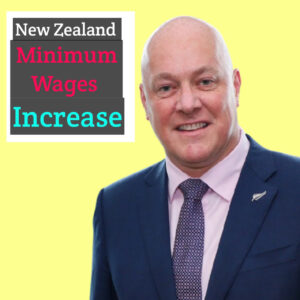New Zealand has announced a new increase to its minimum wage starting April 2025. The adult minimum wage will go up to $23.50 per hour, a small increase from $23.25 in 2024. This change, although minor at first glance, is part of the government’s plan to keep wages in line with inflation and support workers’ financial needs.
This new wage rule doesn’t just apply to adult workers. Young workers and trainees will also see a pay rise—from $18.52 to $18.80 per hour. This change helps around 141,900 people in New Zealand, offering them better income security. For full-time workers, it means about $14 more each week, or $728 more each year.
Although this is a modest raise, it matters a lot for people earning the minimum wage. More income means better support for daily needs like food, rent, and transportation. The increase also helps the country grow economically by giving people more money to spend. Employers and business owners will need to prepare for these changes as part of their yearly planning.
Updated Wage Rates for 2025

Here is a simple breakdown of the new minimum wage rates in New Zealand for 2025:
| Wage Category | Previous Rate (2024) | New Rate (2025) | Increase Amount | Percentage Increase |
|---|---|---|---|---|
| Adult Minimum Wage | $23.25 per hour | $23.50 per hour | $0.35 | 1.5% |
| Starting-Out Minimum Wage | $18.52 per hour | $18.80 per hour | $0.28 | 1.5% |
| Training Minimum Wage | $18.52 per hour | $18.80 per hour | $0.28 | 1.5% |
This 1.5% increase is equal across all categories. It’s meant to be fair and easy for employers to follow while making sure workers get a better wage. For full-time workers, the added income makes a real difference over time.
What Workers Can Expect from This Wage Hike
1. More Take-Home Pay
Those earning minimum wage will see their earnings grow. For someone working 40 hours a week, that’s about $14 more per week before taxes.
2. Better Spending Power
With inflation under control for the first time in years, this raise helps workers maintain their ability to buy essentials. This means their money won’t lose value quickly.
3. Boost for Youth and New Workers
Young people and those in training positions will also benefit from this increase. It helps reduce the income gap and encourages more young people to join the workforce.
4. Positive Ripple Effect
When workers have more money, they tend to spend more. This helps local businesses and the overall economy, especially in areas like retail and services.
Steps Employers Should Take to Get Ready
1. Let Your Workers Know
If you employ people on minimum wage, inform them about the pay raise. This can be done through official letters or updates to their contracts.
2. Update Payroll Systems
Before 1 April 2025, make sure your payment systems reflect the new wages. Mistakes in pay can lead to penalties.
3. Review Pay Structures
As minimum wage rises, workers slightly above that level might also expect a raise. It’s wise to look at your pay system to avoid staff dissatisfaction.
4. Adjust Business Budgets
Higher wages mean higher costs. Plan your finances to absorb this change, especially if you’re running a small business.
5. Train and Upskill Workers
If you’re paying more, it may help to improve worker productivity through training. Skilled staff can bring better results, making the wage hike more manageable.
Special Wage Permits for Disabled Employees
In some cases, workers with significant disabilities may be paid below the minimum wage, but only under strict rules. Here’s how that works:
- Employer Must Prove the Need: The business has to show that the worker’s disability limits the kind of work they can do.
- Consent is Required: The worker must agree to the arrangement willingly.
- Efforts Must Be Made to Accommodate: Employers need to show they tried to find ways to help the worker before asking for a wage exemption.
These rules are in place to protect disabled workers while also allowing flexibility in special cases.
What the Pay Raise Means for the Whole Economy
1. More Consumer Spending
When workers have extra money, they’re more likely to spend it. This helps stores, cafes, and service businesses grow.
2. Challenges for Small Businesses
Smaller companies may find it hard to cover the extra payroll costs. They might need to cut spending in other areas or rethink their operations.
3. Stable Inflation
The 1.5% raise was carefully planned so that it wouldn’t drive up prices too much. It supports economic growth without adding inflation pressure.
4. Stronger Workforce in the Long Run
Fairer wages lead to happier employees. Over time, this can mean better work, higher output, and less staff turnover.